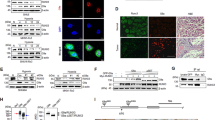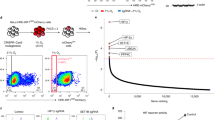Abstract
Hypoxia-inducible factor 1α (HIF-1α) is frequently overexpressed in human cancers and controls the expression of several genes that have been implicated in tumor growth and progression. Activity of HIF-1α in cancer cells is regulated at the transcriptional, translational and posttranslational level by multiple inter- and coacting molecular pathways. In this report, we reveal for the first time that tumor-associated CpG demethylation facilitates positive autoregulation of HIF-1α, resulting in amplification of hypoxia-induced transactivation of HIF-1α target genes. The HIF-1α promoter harbors a hypoxia response element that is normally repressed by methylation of a CpG dinucleotide located in the core element. In colon cancer cell lines and in primary colon cancer specimens, however, we found frequent aberrant demethylation of this element, enabling binding of HIF-1α to its own promoter resulting in autotransactivation of HIF-1α expression. Our results provide novel and highly unexpected insights into the complexity of HIF-1α regulation in cancer cells and implicate that tumor-associated CpG demethylation augments HIF-1α-mediated effects on malignant cell growth.
This is a preview of subscription content, access via your institution
Access options
Subscribe to this journal
Receive 50 print issues and online access
$259.00 per year
only $5.18 per issue
Buy this article
- Purchase on Springer Link
- Instant access to full article PDF
Prices may be subject to local taxes which are calculated during checkout




Similar content being viewed by others

References
Angel P, Hattori K, Smeal T, Karin M . (1988). The jun proto-oncogene is positively autoregulated by its product, Jun/AP-1. Cell 55: 875–885.
Bilton RL, Booker GW . (2003). The subtle side to hypoxia inducible factor (HIFα) regulation. Eur J Biochem 270: 791–798.
Bruick RK, McKnight SL. (2001). A conserved family of prolyl-4-hydroxylases that modify HIF. Science 294: 1337–1340.
Chen H, Ray-Gallet D, Zhang P, Hetherington CJ, Gonzalez DA, Zhang DE et al. (1995). PU.1 (Spi-1) autoregulates its expression in myeloid cells. Oncogene 11: 1549–1560.
Chen RP, Ingraham HA, Treacy MN, Albert VR, Wilson L, Rosenfeld MG . (1990). Autoregulation of pit-1 gene expression mediated by two cis-active promoter elements. Nature 346: 583–586.
Conrad PW, Freeman TL, Beitner-Johnson D, Millhorn DE . (1999). EPAS1 trans-activation during hypoxia requires p42/p44 MAPK. J Biol Chem 274: 33709–33713.
Eden A, Gaudet F, Waghmare A, Jaenisch R . (2003). Chromosomal instability and tumors promoted by DNA hypomethylation. Science 300: 455.
Ehrlich M . (2002). DNA methylation in cancer: too much, but also too little. Oncogene 21: 5400–5413.
Ema M, Taya S, Yokotani N, Sogawa K, Matsuda Y, Fujii-Kuriyama Y . (1997). A novel bHLH-PAS factor with close sequence similarity to hypoxia-inducible factor 1α regulates the VEGF expression and is potentially involved in lung and vascular development. Proc Natl Acad Sci USA 94: 4273–4278.
Esteller M . (2008). Epigenetics in cancer. N Engl J Med 358: 1148–1159.
Feinberg AP . (1988). Alterations in DNA methylation in colorectal polyps and cancer. Prog Clin Biol Res 279: 309–317.
Feinberg AP, Gehrke CW, Kuo KC, Ehrlich M . (1988). Reduced genomic 5-methylcytosine content in human colonic neoplasia. Cancer Res 48: 1159–1161.
Gaudet F, Hodgson JG, Eden A, Jackson-Grusby L, Dausman J, Gray JW et al. (2003). Induction of tumors in mice by genomic hypomethylation. Science 300: 489–492.
Goelz SE, Vogelstein B, Hamilton SR, Feinberg AP . (1985). Hypomethylation of DNA from benign and malignant human colon neoplasms. Science 228: 187–190.
Holmquist-Mengelbier L, Fredlund E, Lofstedt T, Noguera R, Navarro S, Nilsson H et al. (2006). Recruitment of HIF-1α and HIF-2α to common target genes is differentially regulated in neuroblastoma: HIF-2α promotes an aggressive phenotype. Cancer Cell 10: 413–423.
Iliopoulos O, Levy AP, Jiang C, Kaelin Jr WG, Goldberg MA . (1996). Negative regulation of hypoxia-inducible genes by the von Hippel-Lindau protein. Proc Natl Acad Sci USA 93: 10595–10599.
Jaakkola P, Mole DR, Tian YM, Wilson MI, Gielbert J, Gaskell SJ et al. (2001). Targeting of HIF-α to the von Hippel-Lindau ubiquitylation complex by O2-regulated prolyl hydroxylation. Science 292: 468–472.
Jaenisch R, Schnieke A, Harbers K . (1985). Treatment of mice with 5-azacytidine efficiently activates silent retroviral genomes in different tissues. Proc Natl Acad Sci USA 82: 1451–1455.
Kanai M, Wei D, Li Q, Jia Z, Ajani J, Le X et al. (2006). Loss of Krüppel-like factor 4 expression contributes to Sp1 overexpression and human gastric cancer development and progression. Clin Cancer Res 12: 6395–6402.
Karpf AR, Jones DA . (2002). Reactivating the expression of methylation silenced genes in human cancer. Oncogene 21: 5496–5503.
Koslowski M, Bell C, Seitz G, Lehr HA, Roemer K, Muntefering H et al. (2004). Frequent nonrandom activation of germline genes in human cancer. Cancer Res 64: 5988–5993.
Koslowski M, Sahin U, Huber C, Tureci O . (2006). The human X chromosome is enriched for germline genes expressed in premeiotic germ cells of both sexes. Hum Mol Genet 15: 2392–2399.
Koslowski M, Tureci O, Biesterfeld S, Seitz G, Huber C, Sahin U . (2009a). Selective activation of trophoblast-specific PLAC1 in breast cancer by CCAAT/enhancer-binding protein β (C/EBPβ) isoform 2. J Biol Chem 284: 28607–28615.
Koslowski M, Tureci O, Huber C, Sahin U . (2009b). Selective activation of tumor growth-promoting Ca2+ channel MS4A12 in colon cancer by caudal type homeobox transcription factor CDX2. Mol Cancer 8: 77.
Lofstedt T, Fredlund E, Holmquist-Mengelbier L, Pietras A, Ovenberger M, Poellinger L et al. (2007). Hypoxia inducible factor-2α in cancer. Cell Cycle 6: 919–926.
Maxwell PH, Wiesener MS, Chang GW, Clifford SC, Vaux EC, Cockman ME et al. (1999). The tumour suppressor protein VHL targets hypoxia-inducible factors for oxygen-dependent proteolysis. Nature 399: 271–275.
Mazure NM, Chen EY, Laderoute KR, Giaccia AJ . (1997). Induction of vascular endothelial growth factor by hypoxia is modulated by a phosphatidylinositol 3-kinase/Akt signaling pathway in Ha-ras-transformed cells through a hypoxia inducible factor-1 transcriptional element. Blood 90: 3322–3331.
McCormick A, Brady H, Theill LE, Karin M . (1990). Regulation of the pituitary-specific homeobox gene GHF1 by cell autonomous and environmental cues. Nature 345: 829–832.
Nicolaides NC, Gualdi R, Casadevall C, Manzella L, Calabretta B . (1991). Positive autoregulation of c-myb expression via Myb binding sites in the 5′ flanking region of the human c-myb gene. Mol Cell Biol 11: 6166–6176.
Ohh M, Park CW, Ivan M, Hoffman MA, Kim TY, Huang LE et al. (2000). Ubiquitination of hypoxia-inducible factor requires direct binding to the β-domain of the von Hippel-Lindau protein. Nat Cell Biol 2: 423–427.
Sahin U, Koslowski M, Dhaene K, Usener D, Brandenburg G, Seitz G et al. (2008). Claudin-18 splice variant 2 is a pan-cancer target suitable for therapeutic antibody development. Clin Cancer Res 14: 7624–7634.
Semenza GL . (2010). Defining the role of hypoxia-inducible factor 1 in cancer biology and therapeutics. Oncogene 29: 625–634.
Serfling E, Chuvpilo S, Liu J, Hofer T, Palmetshofer A . (2006). NFATc1 autoregulation: a crucial step for cell-fate determination. Trends Immunol 27: 461–469.
Siegfried Z, Cedar H . (1997). DNA methylation: a molecular lock. Curr Biol 7: R305–R307.
Tate PH, Bird AP . (1993). Effects of DNA methylation on DNA-binding proteins and gene expression. Curr Opin Genet Dev 3: 226–231.
Thayer MJ, Tapscott SJ, Davis RL, Wright WE, Lassar AB, Weintraub H . (1989). Positive autoregulation of the myogenic determination gene MyoD1. Cell 58: 241–248.
Wainfan E, Poirier LA . (1992). Methyl groups in carcinogenesis: effects on DNA methylation and gene expression. Cancer Res 52: 2071s–2077s.
Wang GL, Semenza GL . (1993a). Characterization of hypoxia-inducible factor 1 and regulation of DNA binding activity by hypoxia. J Biol Chem 268: 21513–21518.
Wang GL, Semenza GL . (1993b). General involvement of hypoxia-inducible factor 1 in transcriptional response to hypoxia. Proc Natl Acad Sci USA 90: 4304–4308.
Wenger RH, Kvietikova I, Rolfs A, Camenisch G, Gassmann M . (1998). Oxygen-regulated erythropoietin gene expression is dependent on a CpG methylation-free hypoxia-inducible factor-1 DNA-binding site. Eur J Biochem 253: 771–777.
Yin H, Blanchard KL . (2000). DNA methylation represses the expression of the human erythropoietin gene by two different mechanisms. Blood 95: 111–119.
Yu C, Cantor AB, Yang H, Browne C, Wells RA, Fujiwara Y et al. (2002). Targeted deletion of a high-affinity GATA-binding site in the GATA-1 promoter leads to selective loss of the eosinophil lineage in vivo. J Exp Med 195: 1387–1395.
Yu F, White SB, Zhao Q, Lee FS . (2001). HIF-1α binding to VHL is regulated by stimulus-sensitive proline hydroxylation. Proc Natl Acad Sci USA 98: 9630–9635.
Zundel W, Schindler C, Haas-Kogan D, Koong A, Kaper F, Chen E et al. (2000). Loss of PTEN facilitates HIF-1-mediated gene expression. Genes Dev 14: 391–396.
Author information
Authors and Affiliations
Corresponding author
Ethics declarations
Competing interests
The authors declare no conflict of interest.
Additional information
Supplementary Information accompanies the paper on the Oncogene website
Supplementary information
Rights and permissions
About this article
Cite this article
Koslowski, M., Luxemburger, U., Türeci, Ö. et al. Tumor-associated CpG demethylation augments hypoxia-induced effects by positive autoregulation of HIF-1α. Oncogene 30, 876–882 (2011). https://doi.org/10.1038/onc.2010.481
Received:
Revised:
Accepted:
Published:
Issue Date:
DOI: https://doi.org/10.1038/onc.2010.481
Keywords
This article is cited by
-
HIF-1 transcription activity: HIF1A driven response in normoxia and in hypoxia
BMC Medical Genetics (2019)
-
Hypomethylation at non-CpG/CpG sites in the promoter of HIF-1α gene combined with enhanced H3K9Ac modification contribute to maintain higher HIF-1α expression in breast cancer
Oncogenesis (2019)
-
Epigenetic regulators: multifunctional proteins modulating hypoxia-inducible factor-α protein stability and activity
Cellular and Molecular Life Sciences (2018)
-
Non-canonical NFκB mutations reinforce pro-survival TNF response in multiple myeloma through an autoregulatory RelB:p50 NFκB pathway
Oncogene (2017)
-
The Cancer Genome Atlas Analysis Predicts MicroRNA for Targeting Cancer Growth and Vascularization in Glioblastoma
Molecular Therapy (2015)


